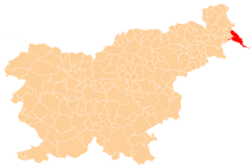Lendava
Lendava (pronounced [ˈleːndaʋa] (![]()
Lendava Dolnja Lendava (until 1955), Hungarian: Lendva | |
|---|---|
 | |
 Lendava Location in Slovenia | |
| Coordinates: 46°33′47″N 16°27′7″E | |
| Country | |
| Traditional region | Prekmurje |
| Statistical region | Mura |
| Municipality | Lendava |
| Area | |
| • Total | 5.66 km2 (2.19 sq mi) |
| Elevation | 161.1 m (528.5 ft) |
| Population (2019)[1] | |
| • Total | 2,942 |
The town is the centre of the Hungarian minority in Slovenia. It is also known for the monumental theater and Hungarian Community Centre designed by the architect Imre Makovecz.
Name
The town is named after the Ledava River; the original nasal in the name of the river was lost in Slovene, but the n in the name of the town was preserved due to Hungarian influence.[2] The former name of the town, Dolnja Lendava (literally, 'lower Lendava'), contrasted with that of Gornja Lendava (literally 'upper Lendava'). The name of the settlement was changed from Dolnja Lendava to Lendava in 1955.[3]
History

Alsólendva was a district (Hungarian: járás) of the Zala comitat in the Kingdom of Hungary[4] until 1918. It was part of Hungary again from 1941 to 1945.[5]
Jewish community
The first census of the population in the beginning of the 18th century mentions two Jewish merchants, and the following censuses showed an increasing Jewish population composed of merchants, innkeepers, distillers, mead producers, lawyers, and physicians. They played an important role in the economy of Lendava, owning a local hotel, a few pubs, and stores. Local Jews also started the first bank in Lendava. A Jewish school opened in 1850 and it was active until 1921. The last rabbi in Lendava was Mor Lowy.[6]
The synagogue in Lendava is one of only two synagogues left in Slovenia.
Landmarks
Church
The parish church in the settlement is dedicated to Saint Catherine of Alexandria and belongs to the Roman Catholic Diocese of Murska Sobota.[7] There is also a Lutheran church in the town. It was built in 1931.
Castle
Lendava Castle is a former property of the Esterházy family. The mainly 18th-century building stands on a hill above the town centre and contains a museum and a gallery.[8]
References
- "Naselje Lendava". Statistični urad Republike Slovenije. Retrieved 16 February 2020.
- Snoj, Marko (2009). Etimološki slovar slovenskih zemljepisnih imen. Ljubljana: Modrijan and Založba ZRC. p. 230.
- Spremembe naselij 1948–95. 1996. Database. Ljubljana: Geografski inštitut ZRC SAZU, DZS.
- Handbook of Austria and Lombardy-Venetia Cancellations on the Postage Stamp Issues 1850-1864, by Edwin Mueller, 1961.
- Lendava municipal site
- Jews of Lendava
- Družina RC Church in Slovenia site
- "Lendava Museum Gallery official site". Archived from the original on 5 November 2009. Retrieved 4 September 2009.
External links

| Wikivoyage has a travel guide for Lendava. |
